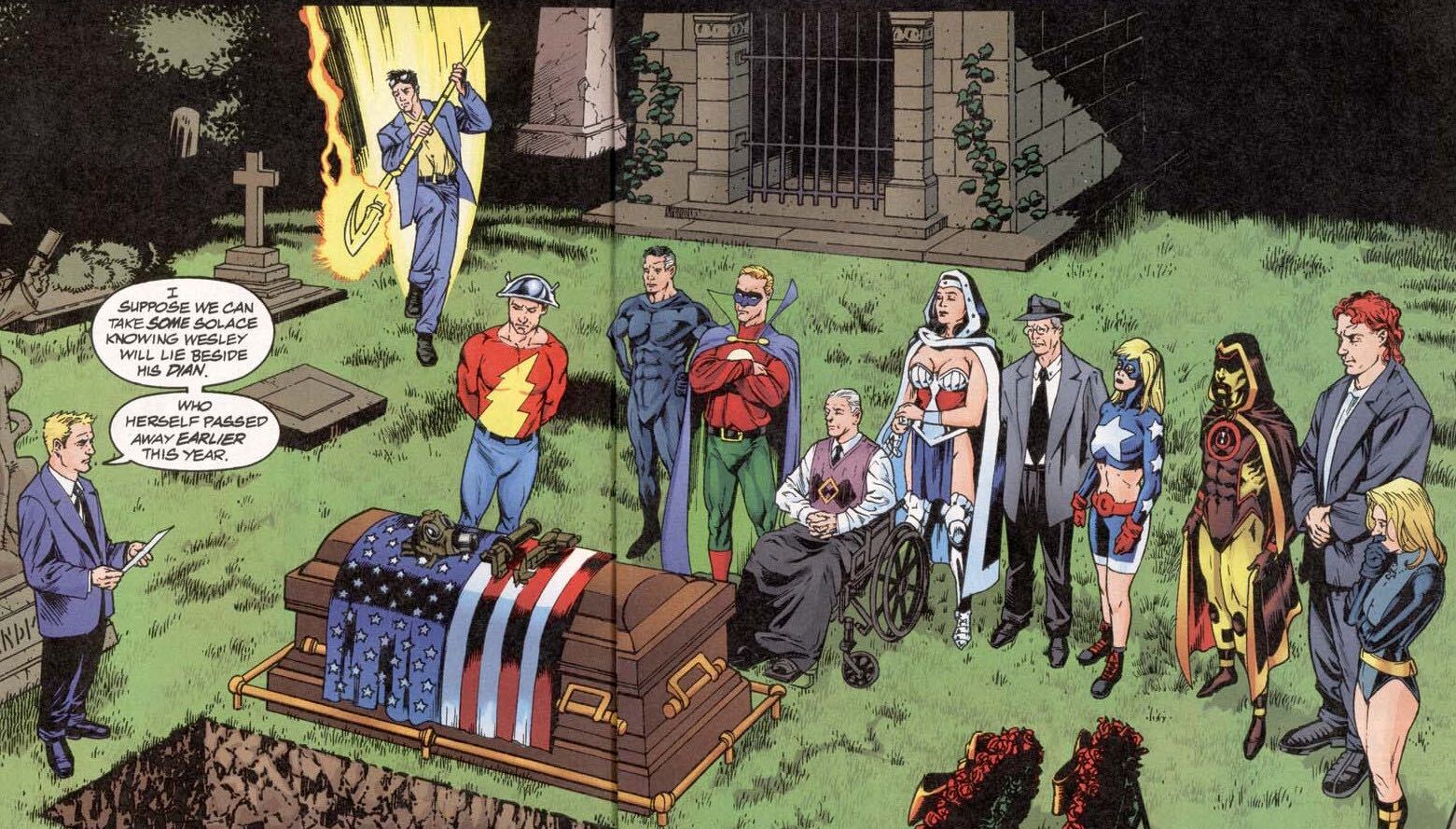Review: JSA: Justice Be Done
 [Editor’s Note: This review may contain spoilers]
[Editor’s Note: This review may contain spoilers]
Writers: James Robinson & David S. Goyer
Art Scott Benefiel, Stephen Sadowski, Derec Aucoin, Mark Propst & Michael Bair
Colors: John Kalisz
Letters: Ken Lopez
Reviewed by: Matthew B. Lloyd
Summary
In Zero Hour: Crisis in Time, the Justice Society of America suffered a major defeat, with numerous members of their ranks dying in battle to save the Universe. This event put the majority of DC’s Golden Age characters on the back burner for a few years, although, the newest incarnation of Starman was birthed by this event and went on to a critically acclaimed series by James Robinson, Tony Harris and Peter Snejbjerg. Additionally, in 1999 Geoff Johns had rekindled the Star-Spangled Kid concept in his series Stars and S.T.R.I.P.E. It seemed that the return of the Justice Society of America was poised for a return!
JSA: Justice Be Done collects the first 5 issues of JSA (1999), plus the lead story in JSA: Secret Files and Origins #1 (1999), Wesley Dodds, the Golden Age Sandman has had another prophetic dream and it has lead him to Tibet. Prepared to sacrifice himself for the greater good, he makes sure his old friend, Speed Saunders, a non-costumed Golden Age adventurer is there to help coordinate his plans.
Dodds’ sacrifice brings the remaining living members of the JSA together with some Golden Age legacy characters to complete Dodds’ plan and stop Mordru (yes, that Mordu from the Legion of Super-Heroes!) from finding the newborn child who will be the new Dr. Fate! Along the way, Kendra Saunders makes her first appearance as Hawkgirl and Starman, Jack Knight and Courtney Whitmore, the Star-Spangled Kid are brought into the JSA fold. Appropriately, Sandy the Golden Boy, Dodds’ ward, friend and crime fighting partner finds a new purpose as he discovers his new powers and becomes chairman of the re-formed Justice Society of America.
Positives
With 1985’s Crisis on Infinite Earths, DC Comics made massive continuity changes to many characters. Few characters had a harder time of it than the Golden Age characters who no longer inhabited Earth-Two, but instead were integrated into the history of the single Earth. While it’s true they lost a lot, they also gained an important place as the inspiration of all the modern heroes, Superman, Batman, Wonder Woman etc…. However, their increasing age made them less than believable as Mystery Men. Because of their popularity, on the other hand, the JSA was continually re-imagined with new legacy character to fill out the roster accompanied by a few of the more durable stalwarts of the past.

Justice Be Done does a nice job of bringing a new roster together with both new and familiar faces. Perhaps, the highlight is Goyer and Robinson integrating new legacy characters Jack Knight and Courtney Whitmore. At the time, these were new DC characters and they fit extremely well. Additionally, Kendra Saunders was a welcome addition to the team as a new characters that had a serious Golden Age pedigree, even if everything else about her was new and modern.
Positives Cont’d
Reinventing Sandy as Sand and developing his silicone powers made him quite different from Sandman Wesley Dodds, but kept that link to the JSA. Al Rothstein’s transition to Atom Smasher is a similar character development. While the original Black Canary, Dinah Drake was a member of the JSA in the Golden Age, her daughter, Dinah Lance had always been associated with the Justice League of America. Black Canary is a perfect addition to the JSA that makes complete sense. It’s something that could never have happened on Earth-Two. Finally, the reveal of the identity of Dr. Fate is a nice surprise and even works in some subtle aspects of that character’s history that play well with reincarnation.
Character is a strong element for this opening chapter of the re-formed JSA. These characters have maintained a fan following throughout the years because they are so fitted to character development. The old guys and gals have gone through so many life experiences that they feel more real because of it. As they have children, get married, retire, train proteges, they are more relatable to the reader through events that are recognizable in their own lives.
Robinson and Goyer do a really nice job of integrating Courtney’s characterization from her own series, with Jack Knight echoing my own “bratty” assessment of her personality. But, by the end of the story arc, there’s a real sense that these characters will grow together over the ensuing issues.
Negatives
Mordru is a bit of a strange choice for a JSA villain. He does, however, fit nicely into the the magic element that comes along with Dr. Fate’s return. And, while it serves the purpose of bringing the JSA back together, I can’t help wondering if a traditional JSA villain like Vandal Savage or Per Degaton would’ve been a better choice.
Verdict
JSA: Justice Be Done is a very good character driven reintroduction of the Justice Society of America for the 21st Century. It’s interesting to note that this series went on for 7 years over the course of 87 issues. It was immediately relaunched as Justice Society of America after the Five Years Later event and continued on for another 4 years and 54 issues plus 3 annuals. Additionally, this 12 year total run also spawed two spin-off series, JSA CLassified which ran for 39 issues ad JSA All-Stars which ran for 18 issues. The only thing that stopped this incarnation of the JSA was “The New 52.”
Justice Be Done is a starting point. It successfully gets the JSA back up and running with enough potential peppered throughout that teases the great things that would come in the subsequent series. If you just can’t wait for the JSA to return in their own book, Justice Be Done is the first chapter in a 12-year epic!
